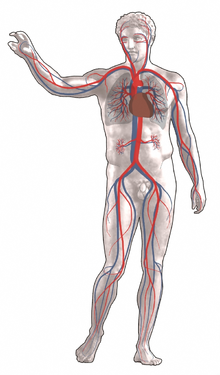Blood
![]()
The title of this article is ambiguous. For other meanings, see Blood (disambiguation).
Blood (Latin Sanguis, Ancient Greek αἷμα haima) is a bodily fluid which, with the support of the cardiovascular system, ensures the functionality of the various body tissues via a variety of transport and linking functions. Blood is referred to as "fluid tissue", occasionally as "fluid organ". Blood consists of special cells as well as the protein-rich blood plasma, which acts as a carrier of these cells in the cardiovascular system.
Blood is pumped through the body's blood vessels primarily by mechanical action of the heart in a circulatory system. Venous valves in combination with muscle work support this. The vessels leading away from the heart are called arteries and those leading back to the heart are called veins. The vascular system of the adult human body contains about 70 to 80 ml of blood per kg of body weight, which is equivalent to about 5 to 6 l of blood. On average, men have about 1 l more blood than women, mainly due to differences in height and weight.
Due to the similarities in function, blood is similar in all vertebrates. Existing differences between human and animal blood are referred to in the article. For differences in the structure and function of the cellular components of blood, please refer to the relevant articles.
The loss of blood is called bleeding (from Middle High German bluoten) or haemorrhage.

From left to right: erythrocyte, thrombocyte, leukocyte

Circulation

Dark field image of human blood, 1000x magnification
Etymology
The common Germanic word "Blut" (from Middle High German and Old High German bluot) probably belongs in the sense of "flowing" to Indo-Germanic bhlê- "to swell", and bhel- "to swell, bud, blossom" (compare English blow). According to ancient tradition, blood is considered the seat of life, hence the origin of compounds such as blood vengeance, blood guilt.
Evolution
Every cell depends on material exchange with its environment to maintain its metabolism. Since, with the development of more complex multicellular organisms, not every cell is in direct contact with the body surface and diffusion is a very slow process whose time requirement is proportional to the square of the distance, a transport medium becomes necessary for these exchange processes as the size of the living organism increases. This fluid therefore brings the substances close to the target cells and thus shortens the necessary diffusion distance.
In animals with open blood circulation (e.g. arthropods or molluscs), blood and interstitial fluid (fluid in the space between tissues) are not separated. The fluid circulating here is called hemolymph. Insects compensate for the disadvantage of relatively slow blood flow in an open circulatory system by the fact that the haemolymph does not serve to transport oxygen, but this is provided by tracheae. In all animals with a closed blood circulation, including all vertebrates, the circulating fluid is called "blood".
Questions and Answers
Q: What is blood?
A: Blood is a liquid found in humans and many animals.
Q: What is the function of blood in the body?
A: Blood brings nutrients and oxygen to our tissues, as well as taking away waste and carbon dioxide from tissues.
Q: What is blood made up of?
A: Blood is made up of blood plasma and various cells, including red blood cells, white blood cells, and platelets.
Q: What is the role of platelets in blood?
A: Platelets help blood to clot.
Q: What is hemoglobin?
A: Hemoglobin is a protein in red blood cells that carries oxygen to tissues.
Q: What is the function of white blood cells?
A: White blood cells help fight infections and heal wounds.
Q: How is blood pushed through the body?
A: Blood is pushed through the body by the heart.
Search within the encyclopedia